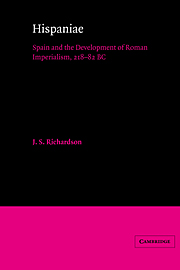Book contents
- Frontmatter
- Contents
- List of maps
- Preface
- Abbreviations
- 1 Spain and Roman imperialism
- 2 Spain before the Romans
- 3 The war zone: 218–206
- 4 Continuity and adaptation: 206–194
- 5 The shaping of the provinciae: 193–155
- 6 The consular provinciae: the wars in Spain 155–133
- 7 From provinciae to provinces: 133–82
- 8 Rome, Spain and imperialism
- Appendices
- I Praetors and provinciae 197–195
- II The chronology of the Spanish provinciae 155–133
- III The chronology of the Spanish provinciae 133–81
- IV The sources of Appian's Ibērikē, with special reference to the events of 152–151
- V The Tabula Alcantarensis
- Bibliography
- Index
IV - The sources of Appian's Ibērikē, with special reference to the events of 152–151
Published online by Cambridge University Press: 07 September 2009
- Frontmatter
- Contents
- List of maps
- Preface
- Abbreviations
- 1 Spain and Roman imperialism
- 2 Spain before the Romans
- 3 The war zone: 218–206
- 4 Continuity and adaptation: 206–194
- 5 The shaping of the provinciae: 193–155
- 6 The consular provinciae: the wars in Spain 155–133
- 7 From provinciae to provinces: 133–82
- 8 Rome, Spain and imperialism
- Appendices
- I Praetors and provinciae 197–195
- II The chronology of the Spanish provinciae 155–133
- III The chronology of the Spanish provinciae 133–81
- IV The sources of Appian's Ibērikē, with special reference to the events of 152–151
- V The Tabula Alcantarensis
- Bibliography
- Index
Summary
In 1896 Ed. Schwartz, in what remains the best survey of the sources of Appian's histories, remarked that for the period between the end of the second Punic war and the end of Polybius' histories Appian's account is so close to that of Polybius as to indicate a use of the latter by the former, either directly or through an intermediate source. A closer examination, he argued, revealed sufficient discrepancies to suggest that there was an intermediary, and Schwartz believed this to be an annalist of the Sullan period, but not Valerius Antias. The passages on which he based this analysis were Lib. 67.302–135.643, the fragments of the Makedonikē, Syr. 1.2–47.244 and Mithr. 2.3–7.23. He also added, though with less certainty, Ib. 39.158–60.255. The problems of this section of the Ibērikē and the identification of its sources were complicated by Livy's use of annalistic rather than Polybian material for his account of events in Spain. At any rate Appian does not seem to be using Livy or Livy's sources, as is shown by a comparison of their accounts of Ti. Gracchus in 180–179.
In 1911 Adolf Schulten, in a discussion of the writings of Polybius and Poseidonius on the Iberians, argued that the work of these two historians survived in the accounts of Appian and Diodorus respectively. He pointed out in particular the precision of Appian's placing and description of the camps with which Scipio surrounded Numantia, as revealed in his own excavations, and suggested that this could only have come from Polybius' monograph on the Numantine war.
- Type
- Chapter
- Information
- HispaniaeSpain and the Development of Roman Imperialism, 218–82 BC, pp. 194 - 198Publisher: Cambridge University PressPrint publication year: 1986

